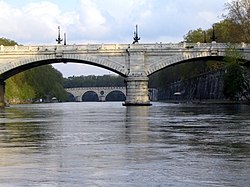Tiber River
The Tiber (Latin: [Tiberis] Error: {{Lang}}: text has italic markup (help), Italian: [Tevere] Error: {{Lang}}: text has italic markup (help)) is the third-longest river in Italy, rising in the Apennine Mountains in Emilia-Romagna and flowing mainly through Umbria and Lazio to the Tyrrhenian Sea, between Ostia and Fiumicino.
| Tiber River | |
|---|---|
| Length | 406 km (252 mi) |
The river is well-known because the city of Rome was founded on its eastern banks.
Geography
The Tiber river has a length of 405 km (252 mi), and a drainage basin with an area of approximately 17,375 km2 (6,709 sq mi), almost 5% of the territory of the country.[1]
It is the third longest river of Italy, after the Po and the Adige rivers, and the second by drainage basin after the Po.[2]
| River | Length (km) | Watershed (km²) |
|---|---|---|
| Po | 652 | 74,970 |
| Adige | 410 | 12,200 |
| Tiber | 405 | 17,375 |
Course
The Tiber starts near the town of Balze, Verghereto comune in the southwestern end of the Forlì-Cesena province, in the southern side of Monte Fumaiolo. The source of the river is formed by two springs that are 10 m (33 ft) from each other in a forest on the mountain at an elevation of 1,268 m (4,160 ft) above sea level.[3]
The Tiber flows through Emilia-Romagna about 4 kilometres (2.5 miles) and then it gets into Tuscany where flows through Pieve Santo Stefano and Sansepolcro. Between these two localities there is a dam with a large reservoir that is named as Montedoglio Lake (Italian: [Lago di Montedoglio] Error: {{Lang}}: text has italic markup (help)). From here, the river flows through a wide plain (Val Tiberina) and gets in the Perugia province (Umbria) and flows through the towns of Città di Castello and Umbertide.[1]
To the south of Torgiano, it is joined by its left side by the Chiascio river and then, in the Marsciano dam, by the Nestore river by its right side. Soon another right tributary, the Paglia, joins the Tiber.[1]
The river forms the border between the Umbria (province of Terni) and Lazio (province of Viterbo) regions. Near the city of Orte, it is joined by the left side by its main tributary, the Nera river.[1]
It flows through the Lazio region (Viterbo, Rieti and Rome provinces) and is joined by the Aniene river, flows through the city of Rome and, finally, into the Tyrrhenian Sea between Ostia and Fiumicino.[1]
Main tributaries
The main tributaries are:
| Tributary | Length | Discharge |
|---|---|---|
| Left tributaries | ||
| Chiascio | 82 km | 19 m³/s |
| Nera | 116 km | 168 m³/s |
| Aniene | 99 km | 35 m³/s |
| Right tributaries | ||
| Nestore | 64 km | 11 m³/s |
| Paglia | 86 km | 11 m³/s |
Discharge
The average yearly discharge (volume of water which passes through a section of the river per unit of time) of the Tiber is 240 m3/s (8,500 cu ft/s) at its mouth.[2]
The mean monthly discharges (in m³) for 2011 in Rome were:
| 644 | 548 | 491 | 316 | 205 | 175 | 97 | 84 | 91 | 324 | 897 | 840 |
| Jan | Feb | Mar | Apr | May | Jun | Jul | Aug | Sep | Oct | Nov | Dic |
Gallery

View of the Tiber looking towards the Vatican City.
Tiber River Media
Rome flood marker, 1598, set into a pillar of the Santo Spirito Hospital near Basilica di San Pietro.
Roman representation of Tiber as a god (Tiberinus) with cornucopia at the Campidoglio, Rome
Related pages
References
- ↑ 1.0 1.1 1.2 1.3 1.4 "Il Tevere" (in Italian). . Autoritá di Bacino del Fiume Tevere. Retrieved 22 February 2017.
{{cite web}}: CS1 maint: unrecognized language (link) - ↑ 2.0 2.1 "Tevere" (in Italian). Treccani.it - Enciclopedie on line. Retrieved 22 February 2017.
{{cite web}}: CS1 maint: unrecognized language (link) - ↑ "Tiber Springs - Monte Fumaiolo". Province of Forlì-Cesena. Archived from the original on 27 September 2013. Retrieved 23 February 2017.
Other websites
| Wikimedia Commons has media related to Lua error in Module:Commons_link at line 62: attempt to index field 'wikibase' (a nil value).. |
- Fiume Tevere - Fiumi Italiani (in Italian)





